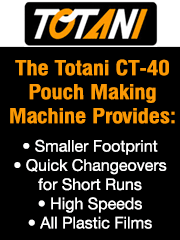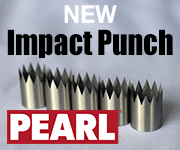Featured Stories
-
-
Static Eliminators for Unwinding, Rewinding and Slitting
For an unwinding or a rewinding roll, where can we put a static dissipater so that it works? -
News | New Products
-
Meech launches 906 Hyperion 24V Power Supply Unit for packaging and converting applications
Meech International has introduced the 906 Hyperion 24V Power Supply Unit (PSU), a compact high-voltage AC power supply with 24VDC input
-
Returnity and Cosmoprof North America Partner to Address Reusable Bag Waste with In Rotation Program
Returnity, a leader in reusable shipping solutions, is excited to announce its partnership with Cosmoprof North America (CPNA) to launch the In Rotation program
-
Print Media Centr Turns Up the Volume on Print
PrintFM, The Industry’s First 24/7 Internet Radio Station, is On-Air!
-
Connecticut Manufacturer Raises Over $7,500 for First Responders, Military Heroes
PACT Presents $7,624.47 Check to Tunnel To Towers Foundation
-
$500 Million Investment at Somerset Mill Expands Sappi’s Leadership in High-End Paperboard for Food, Beverage, and Consumer Packaging
In response to rising demand for high-quality, fiber-based sustainable packaging
-
PPG, GPA Enter Authorized Distributor Partnership for PPG TESLIN Substrate
Teslin synthetic paper for print applications, labels now available through GPA network
-
A Perfect Score: Cortec® Achieves 100% Biobased Content in New Compostable Bioplastic
Cortec® has scored big on biobased content with the launch of its latest bioplastics product.
Expert Advice
What's Ahead for Industrial Ink Jet?
- Published: August 01, 2003, By Ken Stack, Jetrion LLC
What are the best uses for ink jet in an industrial setting? An expert answers questions about the basics of ink jet technology.
Ink jet printing is a well-established, cost-effective solution for short-run and variable information applications. With improvements in print speed and quality, ink jet printing quickly is being integrated into converting operations.
Q: How does ink jet printing differ from other digital printing systems, and what are the benefits it provides to converters?
A: Ink jet is a computer-to-print technology in which digital signals drive droplets of ink through a printhead and then directly onto a substrate. Ink jet printing differs from other plateless digital technologies, like copier or toner-based technologies, because it is noncontact. Ink jet has the ability to print on a wide variety of materials and products, including non-flat surfaces, because the printing device never comes into contact with the substrate.
Like many digital printing systems, ink jet is known for the benefits that it provides for short-run print and variable information applications. But its potential is far greater. Industrial ink jet printing systems can be integrated into existing traditional printing systems cost-effectively to enable converters to provide single-source solutions for customers.
Q: What advice would you give converters looking to integrate ink jet technology into existing traditional printing systems?
A: When considering an investment in ink jet technology, converters should focus first on customer needs — like application, time-to-market, print run, print quality, and cost parameters — rather than the technology itself.
To maximize ROI, they also should consider how ink jet technology will fit into their existing print operations. They must decide whether to incorporate in-line or off-line, and they must understand how the components of their printing systems interact. A good digital printing technology supplier will help them on both fronts.
Q: How do operators decide between drop-on-demand (DOD) or continuous ink jet (CIJ) technology for their printing systems?
A: Speed and print quality are the key considerations. CIJ and DOD are both computer-to-substrate processes — processes that don't require a press — but the action of propelling the ink to substrate is quite different in each.
Most industrial ink jet systems use CIJ technologies. With CIJ, drops of ink are generated in a stream and deflected through a plate to produce an image. Industrial CIJ systems have speeds to 1,000 fpm. That's much faster than DOD. But the image quality is lower than that with DOD technology.
CIJ is the solution of choice for large direct mail-order operations and for product coding and marking in package printing applications for the food, beverage, pharmaceutical, and beauty aide markets. It's also being used in marking and coding lottery tickets.
With DOD, a digital signal produces a single drop of ink on the substrate rather than a stream of ink. Color is formed in a precise collection of dots — not too dissimilar from traditional offset printing. DOD is the ideal choice for full-color, high-precision printing, where quality is the most important consideration. DOD printing can produce near-photographic quality results. DOD can handle print speeds between 100 and 300 fpm.
Applications for DOD include wide-format printing, colored graphics for packaging, point-of-purchase displays, textile, and large format/signage. Many companies are working on devices that will allow DOD to be used for packaging applications as well, such as blister packaging for pharmaceuticals, private label for high-end packaging, and peel lids for special product promotions. However, today they remain niche products due to printing speed constraints.
Q: What types of inks are available today for industrial ink jet printing systems?
A: Just about all — water-, oil- and solvent-based inks and energy-curable inks.
However, converters should make careful choices when selecting ink systems. They have to balance how efficiently the ink runs through a print system with how well the ink performs once it's printed. Working with an ink jet supplier that understands how digital hardware, software, and ink interact is critical to preventing problems and making optimal use of ink jet printing systems.
Q: What substrates/printed media currently are best suited to ink jet technology?
A: Advancements in ink jet inks provide the flexibility to print on just about any medium. Ink jet technology is used in color-proofing for wide-format printing of textiles like wallpaper, carpeting, and even tiles. We're seeing growth in ink jet printing on glass and plastics for packaging applications. Of course, it continues to be used to print on paper and synthetic substrates.
Many substrates today are coated prior to being printed with ink jet, but advances in ink technology are beginning to remove this requirement. The wide range of inks available today continues to expand the range of substrates that can be used for industrial ink jet printing applications.
Q: Are converters concerned about past disappointments with digital systems and suppliers?
A: Indeed, a lot of converters made an investment in digital technology but were disappointed because the digital industry promised more than it could deliver. Misinformation, poor service, and a lack of understanding of the actual customer's requirements have limited the growth of ink jet for packaging. Success is much more than buying an ink jet printer.
Training and management are two considerations that have been overlooked. Managing new workflow, variable data, and image processing are critical to making sure a digital system runs smoothly.
Q: What's the future potential for ink jet technology?
A: Limitless. Packaging is going to be the application to drive ink jet printing into true industrial applications. So in the short run, say the next five to ten years, package printers will see a continuous development of hybrid technologies. Ink jet devices and traditional printing equipment will work in tandem. The digital device will be used to print only variable data — the graphics or text required to change during the run. This will allow end-users to maximize their previous investments while taking advantage of the latest technologies.
Decreasing costs, increasing speeds, and the aging of traditional printing equipment also will drive the adoption of ink jet technology. Over time, converters slowly will begin replacing their existing printing equipment with digital systems. That, however, is many, many years away.
Ken Stack is president of Jetrion LLC, a digital printing company offering a fusion of digital ink, hardware, software, and service solutions to industrial and commercial printers. Jetrion was launched in February 2003 by Flint Ink; Stack is the former VP/general manager of Flint Ink's Digital Div.
The views and opinions expressed in Technical Reports are those of the author(s), not those of the editors of PFFC. Please address comments to author(s).





















